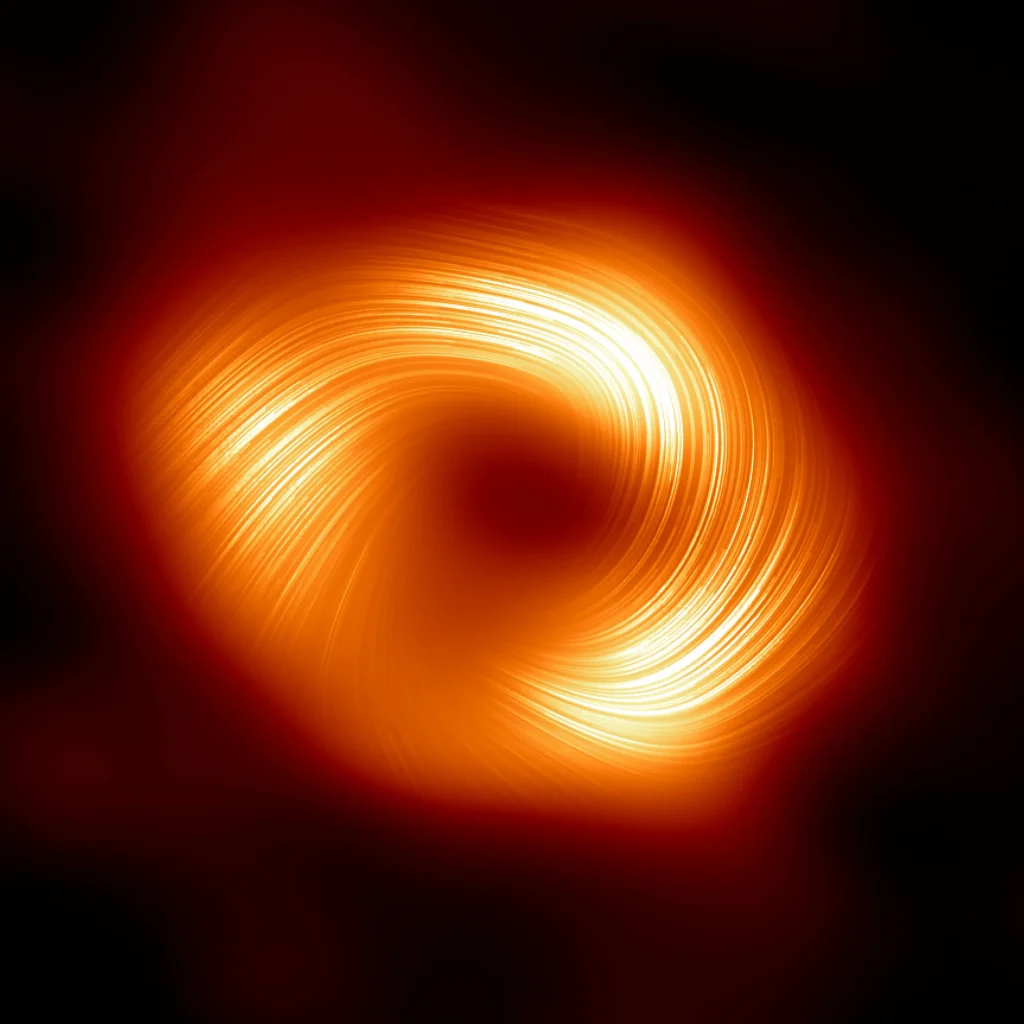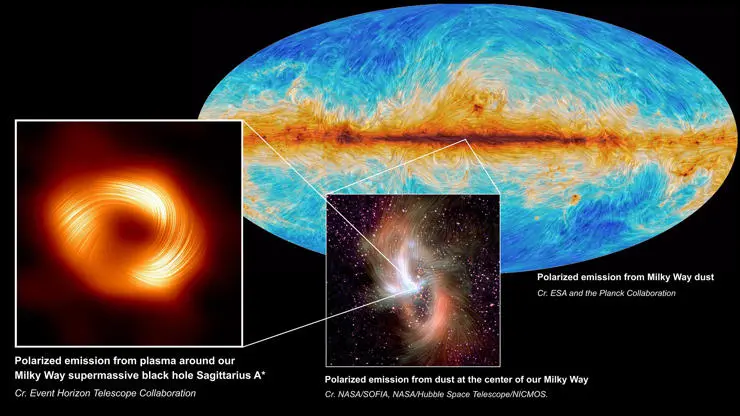
An international team of astronomers, including those from the University of Central Lancashire (UCLan), has uncovered strong and organized magnetic fields spiralling from the edge of the supermassive black hole Sagittarius A* (Sgr A*).
Produced by the Event Horizon Telescope (EHT) collaboration and seen in polarized light for the first time, this new view of the monster lurking at the heart of the Milky Way Galaxy has revealed a magnetic field structure strikingly similar to that of the black hole at the centre of the M87 galaxy, suggesting that strong magnetic fields may be common to all black holes.
This similarity also hints toward a hidden jet in Sgr A*. The results were published today in The Astrophysical Journal Letters.
Scientists unveiled the first image of Sgr A*— which is approximately 27,000 light-years away from Earth— in 2022, revealing that while the Milky Way’s supermassive black hole is more than a thousand times smaller and less massive than M87’s, it looks remarkably similar. This made scientists wonder whether the two shared common traits outside of their looks. To find out, the team decided to study Sgr A* in polarized light. Previous studies of lightaround M87* revealed that the magnetic fields around the black hole giant allowed it to launch powerful jets of material back into the surrounding environment. Building on this work, the new images have revealed that the same may be true for Sgr A*.
Professor Derek Ward-Thompson from UCLan’s Jeremiah Horrocks Institute is a key member of the Event Horizon Telescope collaboration and is the ‘communicating author’ for these latest publications.
“This is a very exciting set of results that allow us to plot the magnetic field around the immediate environment of a black hole” he said.
“The comparison with our previous results on M87* is particularly interesting because M87* is about a thousand times more massive, and yet the magnetic fields of the two appear remarkably similar. This is pointing to fundamental underlying truth about the processes surrounding black holes in general. This is a huge leap forward.”
“What we’re seeing now is that there are strong, twisted, and organized magnetic fields near the black hole at the centre of the Milky Way galaxy,” said Sara Issaoun, NASA Hubble Fellowship Program Einstein Fellow at the Centre for Astrophysics | Harvard & Smithsonian and co-lead of the project. “Along with Sgr A* having a strikingly similar polarization structure to that seen in the much larger and more powerful M87* black hole, we’ve learned that strong and ordered magnetic fields are critical to how black holes interact with the gas and matter around them.”
Light is an oscillating, or moving, electromagnetic wave that allows us to see objects. Sometimes, light oscillates in a preferred orientation, and we call it “polarized.” Although polarized light surrounds us, to human eyes it is indistinguishable from “normal” light. In the plasma around these black holes, particles whirling around magnetic field lines impart a polarization pattern perpendicular to the field. This allows astronomers to see in increasingly vivid detail what’s happening in black hole regions and map their magnetic field lines.
“By imaging polarized light from hot glowing gas near black holes, we are directly inferring the structure and strength of the magnetic fields that thread the flow of gas and matter that the black hole feeds on and ejects,” said Harvard Black Hole Initiative Fellow and project co-lead Angelo Ricarte. “Polarized light teaches us a lot more about the astrophysics, the properties of the gas, and mechanisms that take place as a black hole feeds.”
But imaging black holes in polarized light isn’t as easy as putting on a pair of polarized sunglasses, and this is particularly true of Sgr A*, which is changing so fast that it doesn’t sit still for pictures. Imaging the supermassive black hole requires sophisticated tools above and beyond those previously used for capturing M87*, a much steadier target.
Scientists are excited to have images of both supermassive black holes in polarized light because these images, and the data that come with them, provide new ways to compare and contrast black holes of different sizes and masses. As technology improves, the images are likely to reveal even more secrets of black holes and their similarities or differences.
The EHT has conducted several observations since 2017 and is scheduled to observe Sgr A* again in April 2024. Each year, the images improve as the EHT incorporates new telescopes, larger bandwidth, and new observing frequencies. Planned expansions for the next decade will enable high-fidelity movies of Sgr A*, may reveal a hidden jet, and could allow astronomers to observe similar polarization features in other black holes. Meanwhile, extending the EHT into space will provide sharper images of black holes than ever before.
This research was presented in two papers by the EHT collaboration published today in The Astrophysical Journal Letters: “First Sagittarius A* Event Horizon Telescope Results. VII. Polarization of the Ring” and “First Sagittarius A* Event Horizon Telescope Results. VIII. Physical Interpretation of the Polarized Ring”

